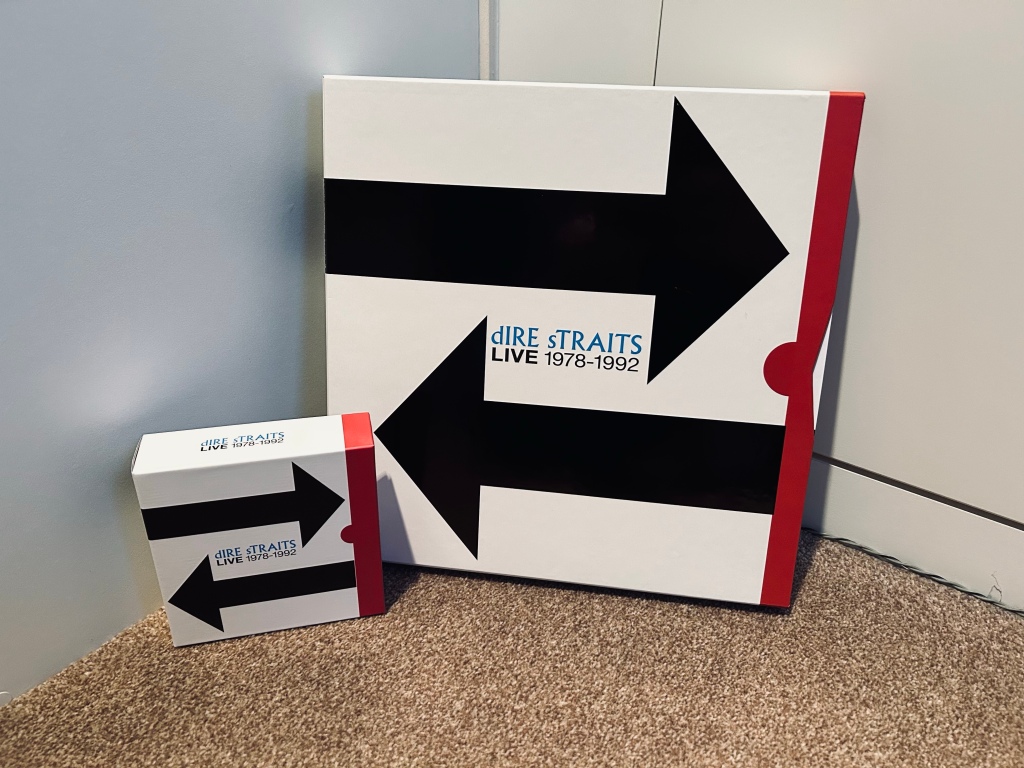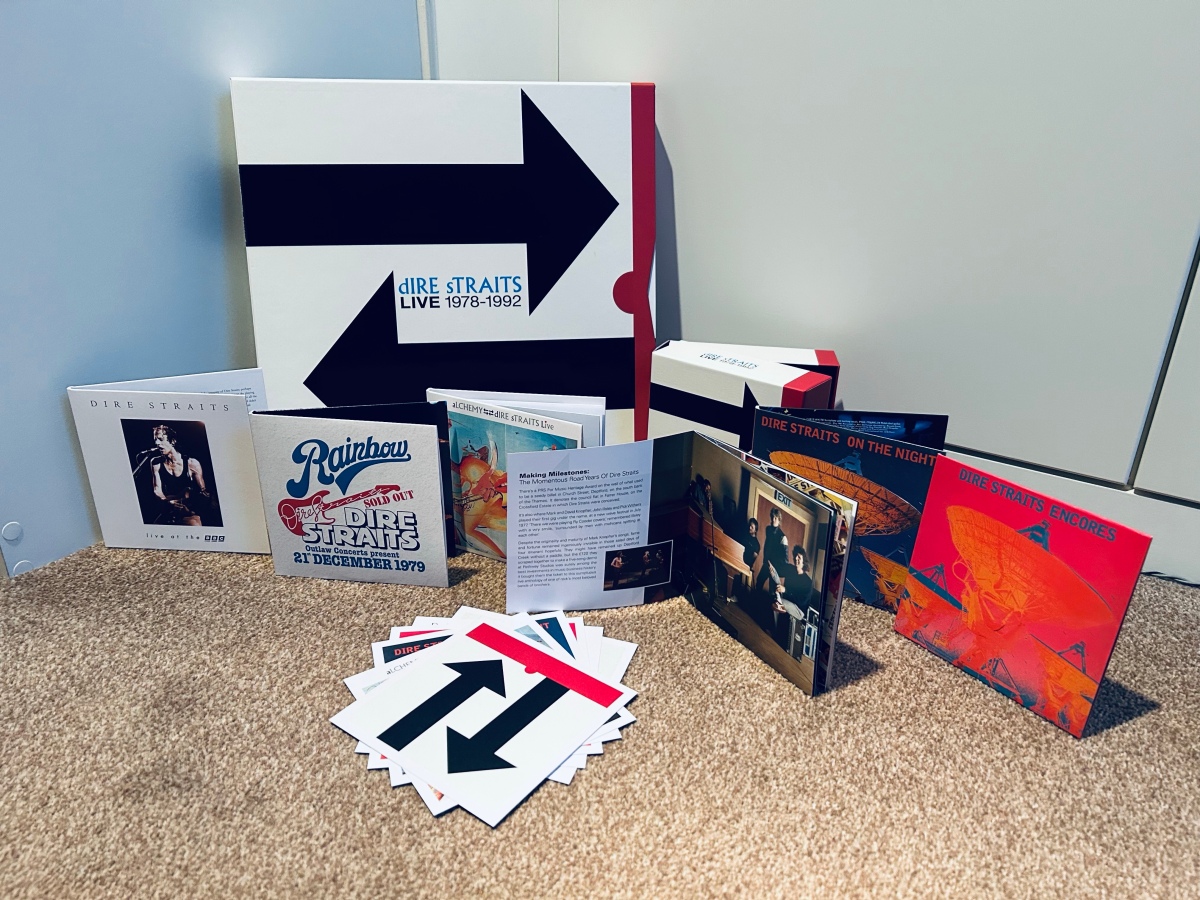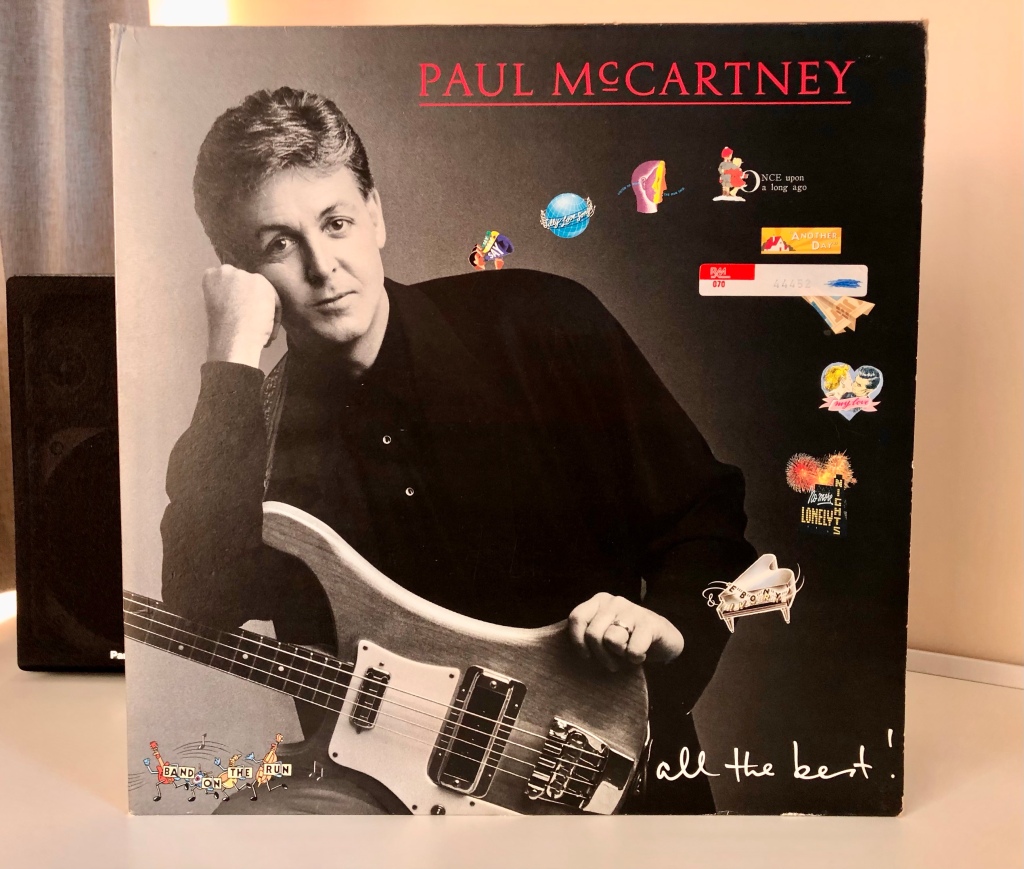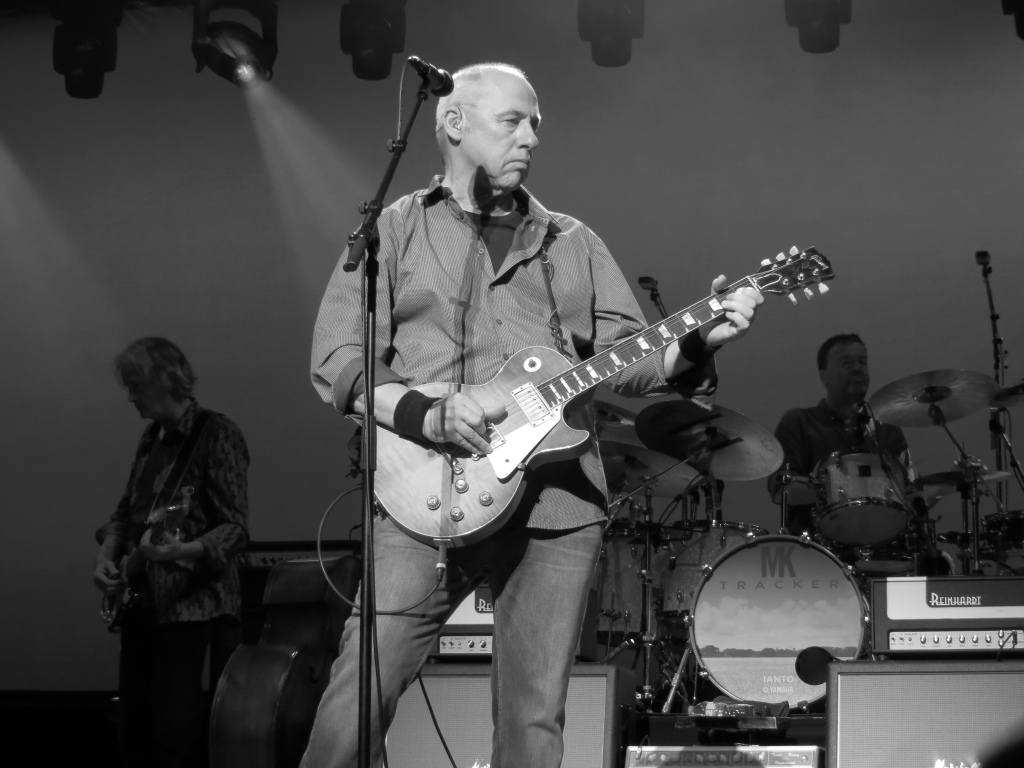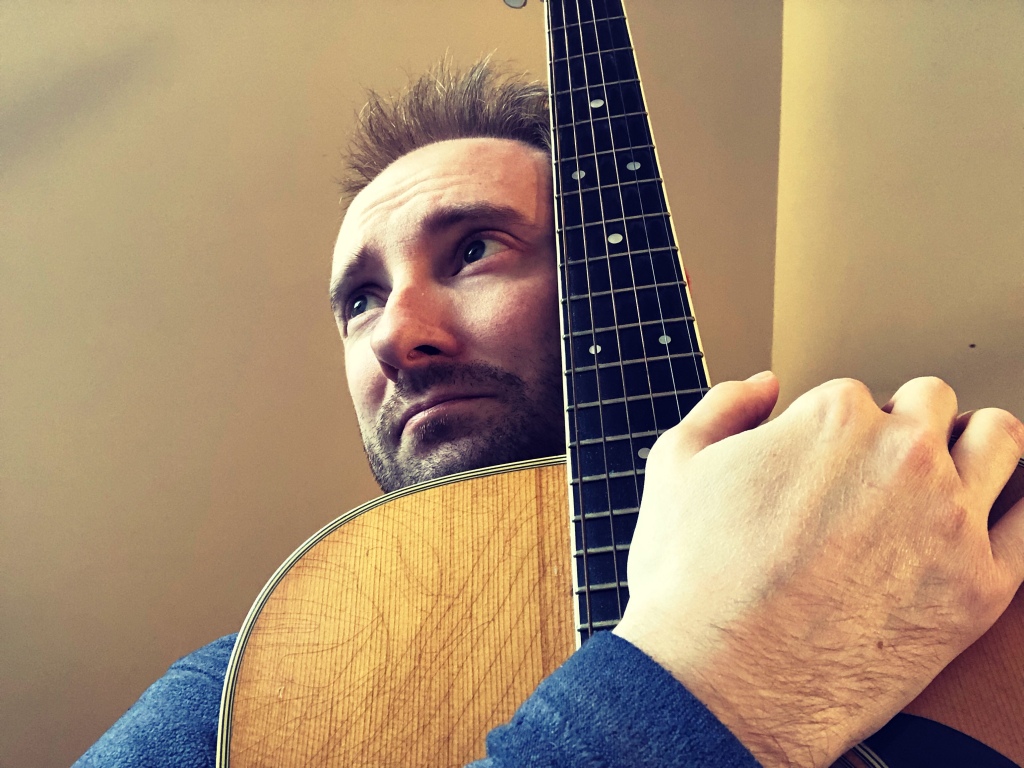If, like me, you are a long-term follower of the career of songwriter / guitarist / vocalist / extraordinaire Mark Knopfler, Christmas seems to have arrived a little early in 2023. Sometime in September, news began filtering through that a rather large box set was on the way. This set would contain all of Dire Straits’ live albums, not only remastered but also expanded with previously unavailable material. Furthermore, it would even contain one entire live album recorded in 1979 that has never before seen any kind of release. I must admit I was a little sceptical. Mark Knopfler himself, such is his relentless focus on writing and recording original material (and long may that continue), has never really been that enthusiastic about digging up the past. Unreleased archive material from Dire Straits has not been terribly forthcoming over the years since the band made their final bows in Zaragoza at the end of the On Every Street tour in October 1992. And to put such a set together would undoubtedly take a good deal of time and effort. It seemed inconceivable to me that something like this could come out of the blue. But happily, my initial scepticism was misplaced. The news wasn’t just an over-ambitious fan dreaming of the ultimate Dire Straits live release. It was actually happening. And so on November 3rd 2023, we received Dire Straits Live: 1978-1992.
And let’s not beat about the bush here. This set is an absolute gem. By some way the most interesting and exciting release by the band since their split in 1992, the CD set contains eight discs, while the vinyl set contains twelve discs. Included are five separate live releases – Live at the BBC (recorded 1978, released 1995), Live at the Rainbow (recorded 1979, previously unreleased), Alchemy (recorded 1983, released 1984) and On the Night along with the Encores EP (recorded 1992, released 1993). Each album has been remastered at Abbey Road under the watchful supervision of longtime Mark Knopfler cohort Guy Fletcher, with Alchemy and On the Night receiving three and seven additional songs respectively, all newly mixed by Guy at Mark’s British Grove Studios in Chiswick, London. And I think I can quite confidently say that we can trust Guy to do the best by this wonderful material. There can’t be many engineers out there with such a good ear for a great mix. As those who have read my previous missives may recall, I still hold Real Live Roadrunning – the live DVD/CD recorded on Mark and Emmylou Harris’ 2006 tour – in extremely high regard. Others have run it close but all these years later, to my ears at least, it remains the best mixed live recording I know of.
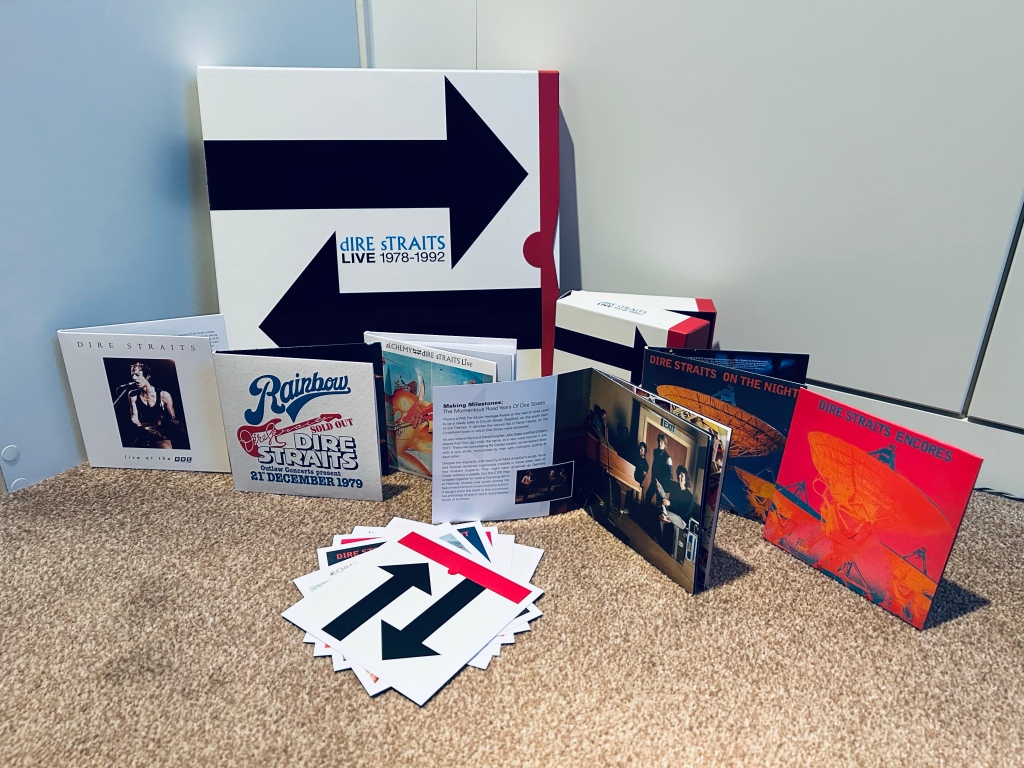
The packaging and artwork of Dire Straits Live is very much in line with the Studio Albums sets which have been in print for several years now, so both will complement one another on your music collection shelf. The CD edition is presented as a gatefold arrangement, though the cases in which the CDs are contained are somewhat sturdier than the basic slipcases we got in the Studio Albums set. The vinyl edition is once again a slipcase design. Both contain a set of album artwork litho prints and a booklet containing photos of the band from down the years along with a newly written essay by veteran music journalist Paul Sexton, who has followed the exploits of Dire Straits and Mark Knopfler since 1978. The discs themselves are all of top quality and have been pressed at Optimal in Germany, as opposed to the last few Dire Straits / Mark Knopfler vinyl releases which were pressed at the GZ Media plant in the Czech Republic and were of a slightly more variable standard. The only issue with my particular set is a slightly off-set label on side B of Alchemy, though the hole has been punched correctly. My only criticism of the vinyl box would be that it is ever so slightly too narrow. On inspecting the contents for the first time, I found that it was quite a challenge to squeeze everything back into the box. It is quite a tight fit, and I have ended up storing the litho prints in a separate plastic wallet. The case just needs to be an eighth of an inch wider. For a twelve disc set, a different arrangement might have been a more practical solution – either a top-loading design with a lid, or possibly a slipcase with an internal binder, similar to the Sting set pictured.

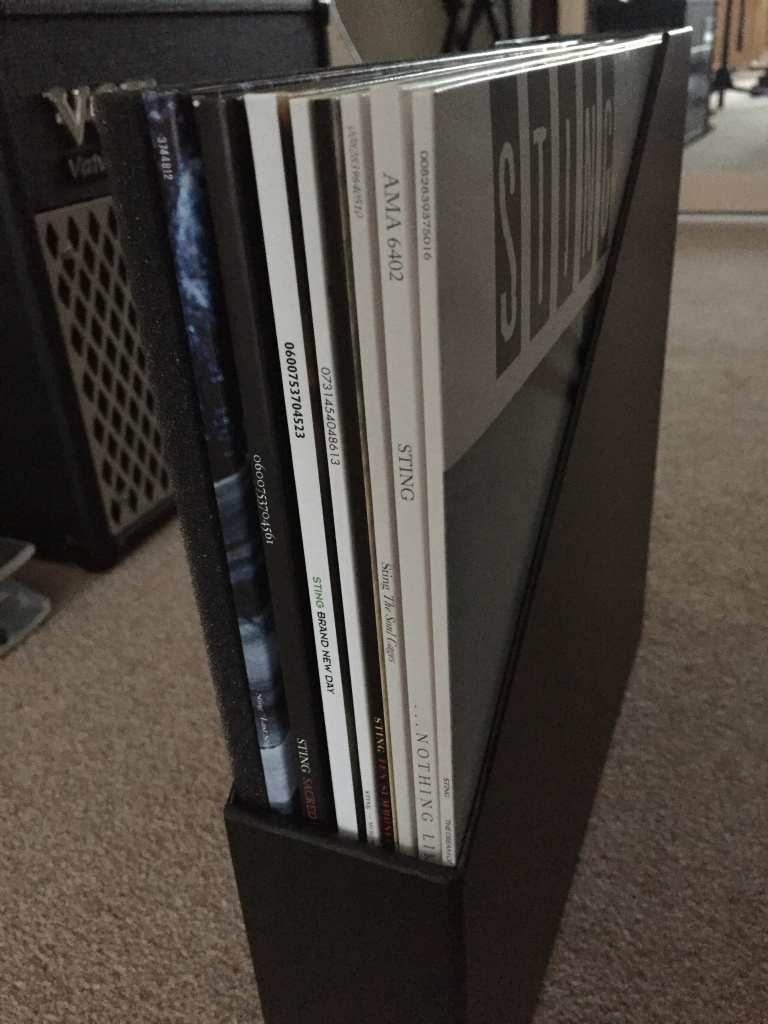
But these are very minor quibbles. Any slight reservations I may have about the packaging are easily overridden by the wonderful music contained within. Let’s take a look at all the albums included in this brilliant set one by one.
LIVE AT THE BBC
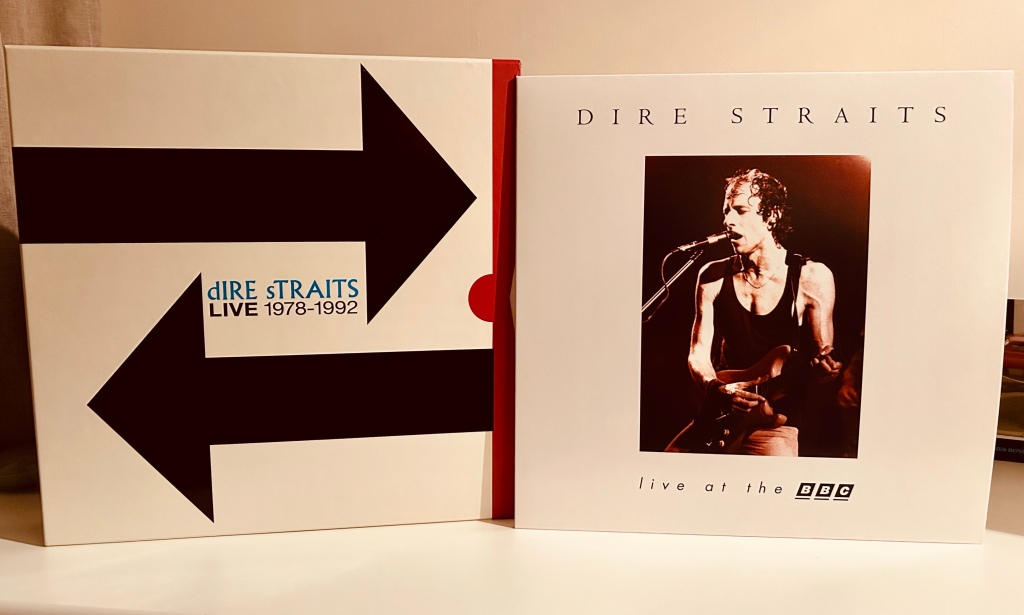
Now here’s a thing. Live at the BBC has existed since 1995 and until now, as big a Dire Straits fan as I may be, I have never actually owned a copy of this album. I don’t know why exactly, but I just never got around to buying it. How could I possibly have allowed my Mark Knopfler / Dire Straits collection to go incomplete for so long?! Well, I must have managed somehow. Predominantly recorded at the BBC’s now defunct Paris Theatre, London (now a fitness club) in July 1978, Live at the BBC was essentially released for contractual reasons. It completed Dire Straits’ recording contract, thereby enabling Mark Knopfler to initiate his solo career which began with the release of Golden Heart in March 1996. It always seemed somewhat of an afterthought to me, which possibly explains why I have overlooked it until the release of the live set. Nonetheless, it is an interesting representative of Dire Straits’ live sound at a very early stage. The band had barely been together for a year. Their self-titled debut album had only been released the previous month. So here we have a seven-song snapshot of Dire Straits when they were still relatively unknown. As you can tell from the recording, there is little fanfare around them at this point. And musically, they were still raw. But, through a slightly poor mix in which Mark’s voice is a tad buried at times, his guitar work stands out powerfully on this recording. You can clearly hear how Mark’s guitar, voice and songs would go on to capture the public’s imagination. What has always puzzled me about this release, however, is the inclusion at the end of ‘Tunnel of Love’. While the first seven tracks were all recorded for the aforementioned BBC radio session in July ’78, ‘Tunnel of Love’ is a somewhat later composition and this particular performance was recorded in 1980. For a start, it is not from the BBC’s Old Grey Whistle Test as suggested in the credits, but was in fact recorded in Dortmund in December 1980. By this time, the line-up had changed and the band had a different sound entirely. Quite apart from the fact that this particular recording is in mono and of a fairly poor quality which I would tend to argue is not really of a good enough standard for an official release, it is totally out of step with the other seven tracks. Guy has done his best to improve it using an effect to open out the sound, but with the original recording being of a low quality there is only so much he could have done. Personally I’d have removed it from the album completely, but that’s just me! That aside, I am nevertheless glad to finally have Live at the BBC in my collection. It fills a gap that should have been filled many moons ago. It is also quite poignant reading the liner notes on the inside cover, written by the late Charlie Gillett who gave the band their first break when he played their demo of ‘Sultans of Swing’ on BBC Radio London in 1977. Rest in peace Charlie.
LIVE AT THE RAINBOW
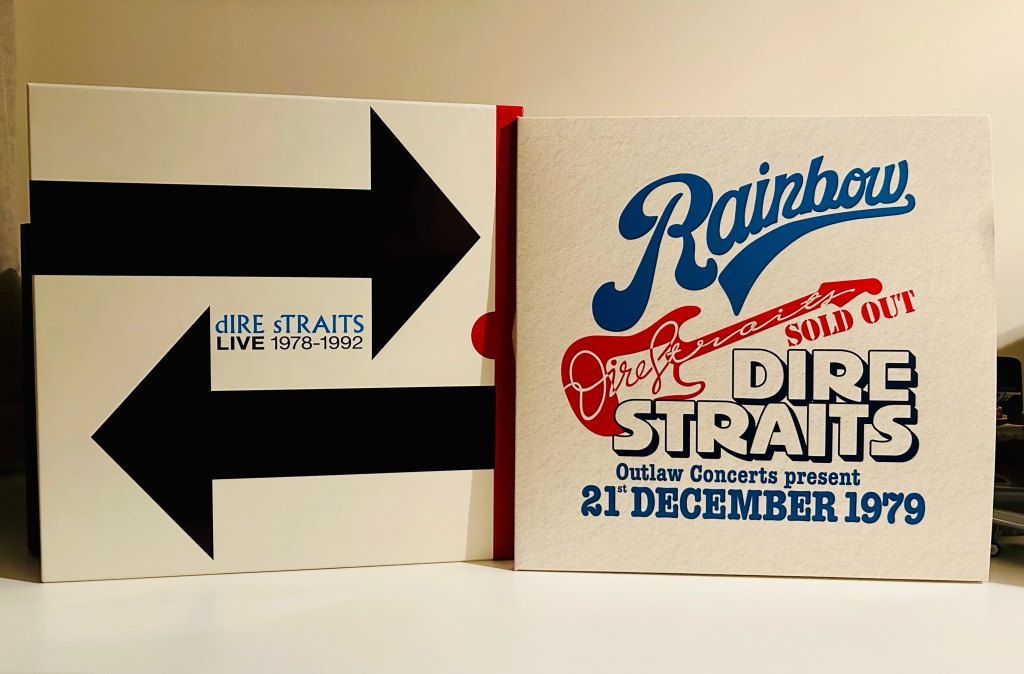
Perhaps the biggest surprise of this set is Live at the Rainbow. Recorded on December 21st 1979, it’s an interesting show for a multitude of reasons. It was the final show of the Communiqué tour, and it was also the final show played by the original Dire Straits line-up. David Knopfler would leave the band during the recording sessions for Making Movies in August 1980. The setlist in fact includes two songs that would later be recorded for that album, namely ‘Solid Rock’ and ‘Les Boys’, and it’s fascinating to hear these songs being performed by the original line-up. The concert also features guest appearances by the late, great Phil Lynott of Thin Lizzy fame and Tony De Meur of New Wave band The Fabulous Poodles for an encore of old-time rock n’ roll tunes. Other than a few clips featured in the BBC’s Arena documentary which focussed on the band and was broadcast in 1980, nobody seemed aware that a complete recording of the show existed. I don’t believe any of us fans could have predicted that we might one day see the issuing an entirely unreleased Dire Straits live album, but lo and behold, here it is. Reading his diary of the production of this box set on his website, it would seem it also took Guy Fletcher somewhat by surprise. Unlike Alchemy and On the Night where the additional songs had to be mixed in such a way that they remained in-keeping with the nature of their existing tracklists, there were no such limitations here. Guy had a clean slate to work from. And what a truly magnificent job he has done. The quality of this album is quite incredible. It might have been recorded almost 44 years ago as I write this article, but it might just as well have been recorded yesterday. It sounds so fresh, and the energy of the band at this point in time comes through in spades. Listening to it almost makes me feel that I am actually in the Rainbow Theatre. I just have to close my eyes and I’m there. Sadly that wouldn’t be possible in reality now, since in 1988 the venue was converted into a Brazilian church which, considering its history and the array of artists that played there, is a huge shame. But the sound really is as clear as a bell, not least because the band at this point was still the original four-piece. There are two guitars, the bass and the drums, plus the backing vocals. It is wonderfully uncluttered and simple. As was typically the case in that relatively early period, Mark’s lead guitar playing is very much at the forefront of the music. Songs such as ‘Lady Writer’ and ‘Sultans of Swing’ feature some frenetic soloing. As the years progressed, Mark’s playing would become more measured – perhaps, quite rightly, more in favour of tone over speed. There is no way he would be so exuberant in later years but in the late 1970s, his speedy fingerpicking on a red 1961 Fender Stratocaster was a defining signature of the music. To be able to hear an immaculate representation of this period of Dire Straits’ live career is really quite something, and I for one am extremely glad we have it.
ALCHEMY
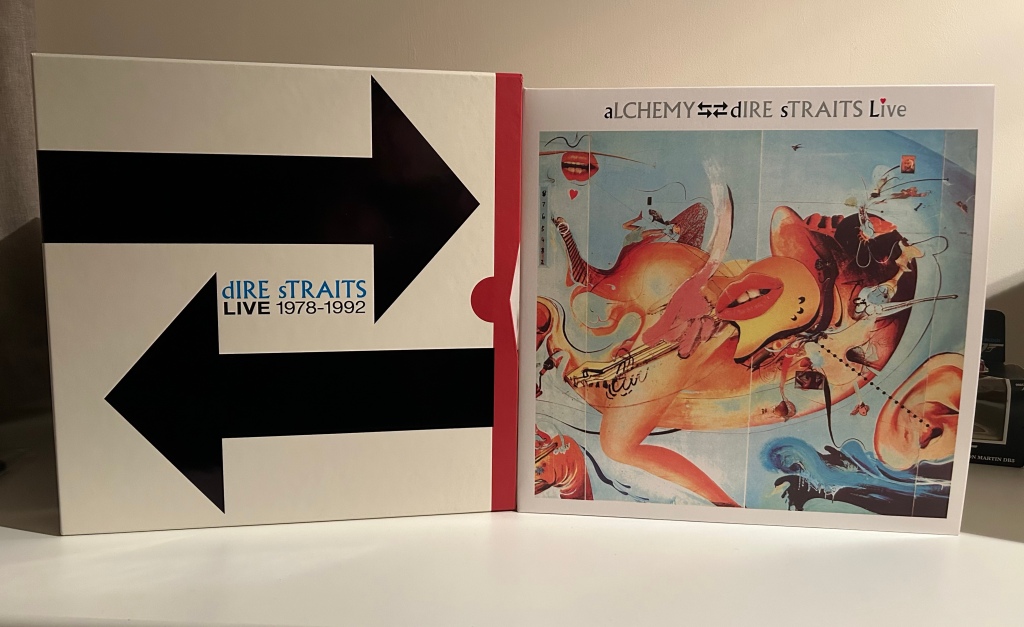
There is little I can say about Alchemy that has not already been said. It is a legendary live album, much loved by many fans. Recorded at the end of the Love Over Gold tour at London’s Hammersmith Odeon in July 1983 and originally released in March the following year, it captures Dire Straits on the cusp of becoming one of the biggest bands on the planet – not long before they would record Brothers in Arms, which would propel them to positively stratospheric heights in 1985. The band had undergone somewhat of a transformation since Live at the Rainbow was recorded. The line-up had expanded, with keyboardist Alan Clark joining, and guitarist Hal Lindes and drummer Terry Williams replacing David Knopfler and Pick Withers respectively. Musically, they were now experimenting much more with synthesisers, effects and the arrangements of the songs themselves. Dire Straits was now a far more dynamic unit than it had been in the early years. Songs such as set opener ‘Once Upon a Time in the West’ and ‘Sultans of Swing’ were now significantly longer than their respective studio versions, gaining new passages and extended solos. The latter of those two songs would remain a set staple in its extended form for the next fifteen years, subtly evolving from tour to tour. Previous CD issues of Alchemy featured eleven tracks, but three more songs recorded at the Hammersmith shows were omitted, those being ‘Industrial Disease’, ‘Twisting By the Pool’ and ’Portobello Belle’. I was always puzzled particularly by the omission of ‘Industrial Disease’, since you can hear the intro of the song at the end of ‘Once Upon a Time in the West’ and the tail end of it at the beginning of ‘Expresso Love’. It seemed an almost cruel tease. Happily however, after all these years, we finally have a version of Alchemy with all three songs slotted into the tracklist. Guy Fletcher has once again worked his magic here. Listening to the album now, which in its vinyl form is now a triple album such is its length, it’s as if these songs had always been a part of it. The transition from the original tracks to those newly added and back again is totally seamless. It’s fantastic to have this historic live album now in a more complete form, albeit with some edits to accommodate it on vinyl. As well as the album, there was of course a concert film of Alchemy, which last saw a reissue on DVD and Blu-ray in 2010. Perhaps we will get another reissue at some time in the future with the previously unreleased songs added. It remains to be seen.
ON THE NIGHT / ENCORES EP
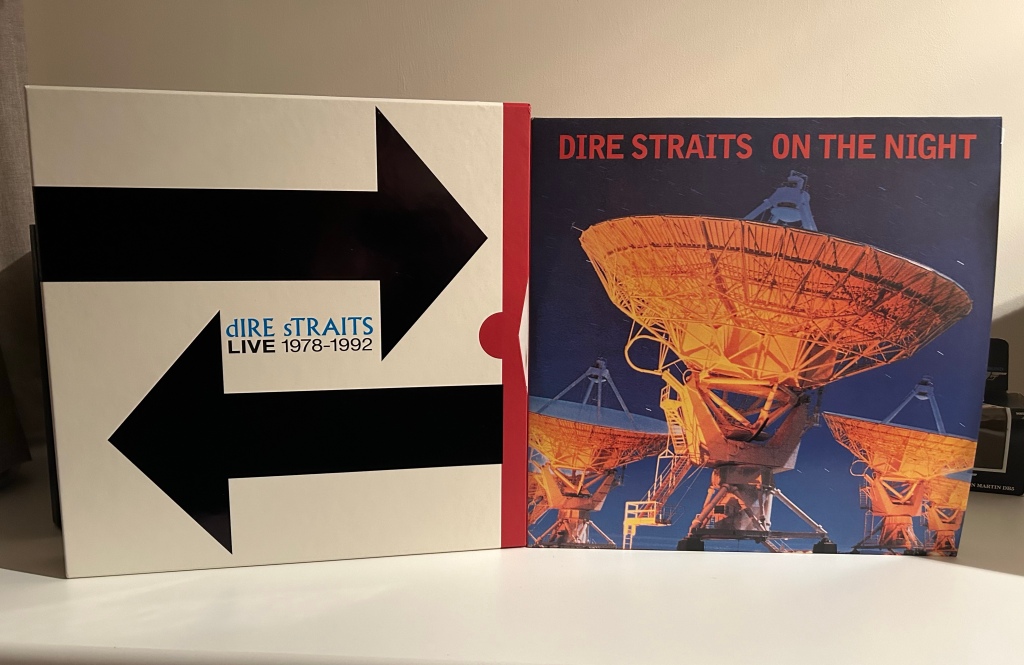

Speaking personally, On the Night is the album I was most looking forward to in this set. On Every Street is probably my favourite period of Dire Straits. The album itself, released in September 1991, has stood the test of time remarkably well and still sounds amazing to this day, over thirty years later. With the band now having established itself among the all-time legendary artists with the runaway success of previous album Brothers in Arms, the associated tour was naturally a large production, visiting huge arenas and stadiums around the world. It began in August 1991 and lasted until October 1992, with a large road crew and two stages that would leapfrog one another to each subsequent venue. Much water had passed under the bridge since the Brothers in Arms tour of 1985-86. Mark had recorded and toured as part of The Notting Hillbillies and had also recorded a collaboration album with Chet Atkins entitled Neck and Neck. And in those five or so years, music and sound production technology had moved on considerably. Effects and synthesisers, for instance, had advanced significantly. The touring line-up had also expanded once again. Dire Straits was now a nine-piece. The result was a significantly different sound to that of the mid-1980s. The On Every Street shows were perhaps the most polished and water-tight that the band had played. Some might argue that the show was too polished. Indeed, the rehearsal time ran into months as opposed to weeks. With everything now being on such a massive scale, Mark had made the decision that this should be the last Dire Straits tour. It wasn’t a farewell tour as such, but I think it’s fair to say that it had the feel of one. And that’s something that I’ve always felt came across quite strongly on the On the Night live album and concert film. Along with the three additional tracks included on the concert film and the Encores EP, the combined original releases gave us thirteen songs recorded across multiple shows in May 1992. There were, however, some glaring omissions including the likes of ‘Sultans of Swing’, ‘Two Young Lovers’ and ‘Telegraph Road’. Until now, we had to rely on TV broadcast bootlegs of shows in Basel and Nîmes in order to hear those songs but with the release of Dire Straits Live, we finally have properly mixed official recordings of them in an expanded edition of On the Night. The album now features seventeen tracks and, in its vinyl form, is now a quadruple album. Added to the Encores EP (of which the edition remastered for Record Store Day Black Friday 2021 is included here), we now have a total of twenty recordings from these shows. We have superb, previously unheard recordings of ‘Fade to Black’ and ‘When it Comes to You’, as well as an excellent performance of ‘I Think I Love You Too Much’, an unreleased song from the On Every Street period. Perhaps of most interest is the addition of a recording of ‘Tunnel of Love’ which, upon first listen, immediately became my new favourite performance of the song. It is simply outstanding and quite an exhilarating listen. I especially love the delay effect on Mark’s Pensa-Suhr MK1, his primary guitar of the time used for both overdriven and clean Strat-like tones. It is an iconic instrument from which Mark achieved some amazing sounds. The performance of ‘You and Your Friend’ is a prime example here. It is among a large number of his instruments being auctioned in January 2024, which makes this extended edition of On the Night all the more poignant. It is an absolute joy to behold from start to finish.
Making my way through this wonderful box set, then, has been a huge pleasure. There are so many gems to unpack, from additional songs added to Alchemy and On the Night that many of us would have assumed we’d never get to hear, to an entirely unreleased live album. It really is a box of sonic treasure. If I’m being honest, to say it is the last word in Dire Straits live recordings would possibly be taking things a little too far. Not every tour is covered – nothing is included from the 1980-81 On Location tour and there is a gaping nine year gap between Alchemy and On the Night, since there are no recordings included from the Brothers in Arms tour. Other than clips from one of the shows during the mammoth Wembley Arena residency of July 1985 uploaded to the official Dire Straits YouTube channel, nothing has ever been properly released from this tour which, considering how significant a period it was for Dire Straits, is really quite perplexing. Perhaps one day we will be surprised once again with a Brothers in Arms live album or concert film, but it depends very much on the availability of multi-tracks of shows from the tour which, it would seem, are in short supply going by Guy Fletcher’s comments on his website. But in the meantime, I cannot possibly have any complaints about what is contained within Dire Straits Live. It is a positively sumptuous collection. And perhaps it is an indication of things to come. Maybe there are more unreleased treasures in the vaults just waiting to be unleashed. Perhaps there will be a similar set (or sets) covering Mark’s solo tours. Well, if Dire Straits Live is anything to go by, that would be something rather special.
Check out Guy Fletcher’s diary entry on the production of DIRE STRAITS LIVE: https://www.guyfletcher.co.uk/dire-straits-live-box-set-2023/
